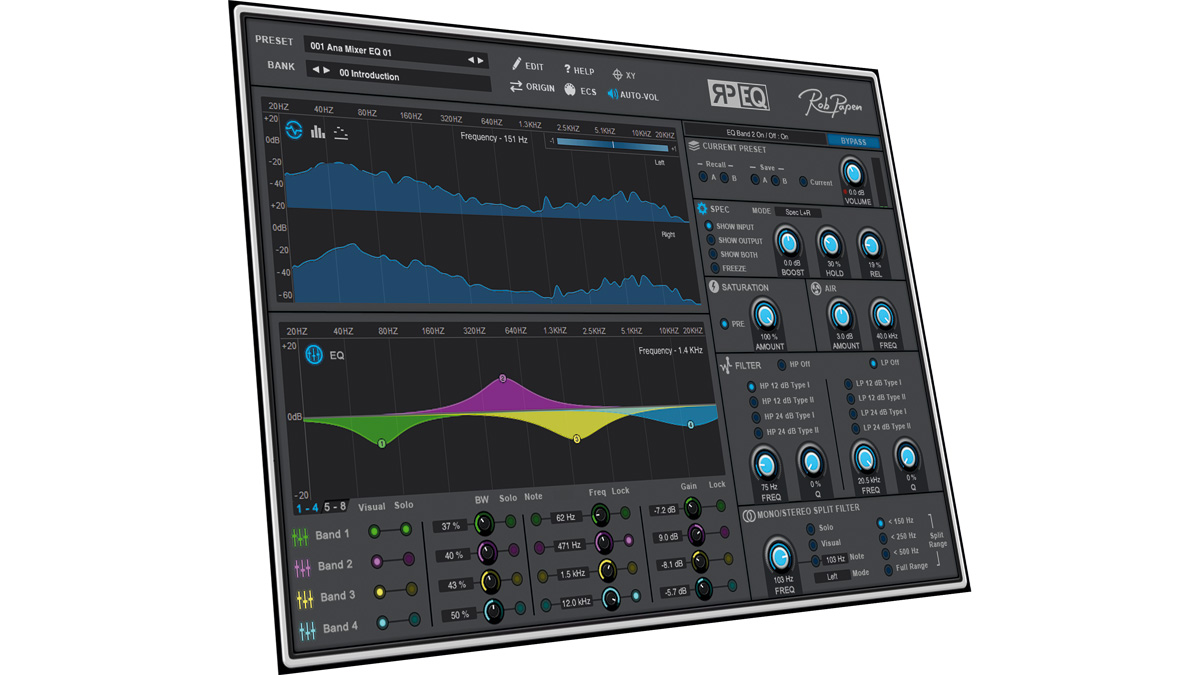MusicRadar Verdict
A comprehensive EQ which performs well in both 'traditional' and creative EQ contexts.
Pros
- +
Comprehensive.
Cons
- -
Busy interface.
MusicRadar's got your back
Rob Papen's RAW synth plug-in was released late last year, promising "aggressive sounds for the EDM generation."
Of course, like many soft synths, its feature set isn't limited only to the traditional modules you'd expect of a synthesizer but also to dedicated effects. Among these within RAW is an EQ section with a character of its very own.
This module has now spawned a dedicated plug-in in its own right, RP-EQ, which takes the guts of the original design and expands it considerably, with new features including mid-side processing and mono/stereo split filtering.
Interface overview
The RP-EQ offers a broodingly dark GUI, with its upper left-hand corner providing a configurable analysis graph of active signals. Below this, you can access each of the eight EQ bands in two blocks of four.
In stereo mode, you can use all eight bands at once, while the mid-side matrix splits them, with 1-4 covering the mid portion and 5-8 dedicated to side-only processing.
Each band features bandwidth (displayed as a percentage), Frequency (which can be toggled between a value shown in Hertz or its equivalent musical note) and a Gain control. Individual bands can be solo'd or temporarily bypassed, so there's scope for real precision here.
The right-hand side provides tools not as readily associated with standard EQ plug-ins, with a range of options which can be switched in or out. These include a dedicated Saturation section, which offers a single dial to add warm distortion to the signal, with Pre and Post EQ colouration both possible.
To the right is an Air band made famous by the Mäag EQ plug-in, which excites upper frequencies between 30kHz and 40kHz to add a more 'open' top-end. A Gain dial lets you adjust to taste. There's a lot to take in on first viewing - RP-EQ eschews the minimalism of other contemporary EQ designs to place most functions on its main page, so expect a period of familiarisation.
Creative EQ
Below this come both low and high-pass filters, with a choice of 12 and 24dB per octave options in both sections, plus Frequency and Bandwidth controls in each category too.
Finally, there's a Mono/Stereo Split Filter, which allows you to divide frequency content into narrower, more focused sounds (great for bass, in particular) while retaining the stereo image of higher frequencies.
RP-EQ also borrows the XY pad from other Rob Papen plug-ins, to provide you with an automatable control surface, to which parameters can be assigned. In this way, you can automate timbral sweeps in real time via MIDI controllers, or engage the internal LFOs to produce evolving tones.
This is a comprehensive and musically creative plug-in which lets you manipulate tone effectively while programming, mixing and even mastering. The interface is busy but it's worth the effort.
“I have an original 909 – every time I try to use it I feel like I’m ruining it”: House hero Riva Starr on his studio essentials and his love of analogue synths
“A synthesizer that is both easy to use and fun to play whilst maintaining a decent degree of programming depth and flexibility”: PWM Mantis review
“I feel like that song had everything we needed to come back with”: Bring Me The Horizon’s Lee Malia on Shadow Moses, its riff and the secrets behind its tone, and why it was the right anthem at the right time










